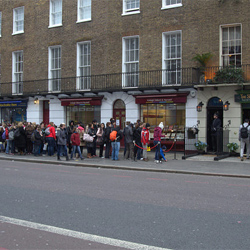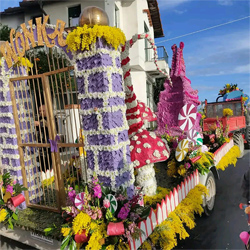The Italian
bar is more than just a café where to sit and have a break…it is a world on its own. The Italian
bar is a café, a diner, a tea room, a lounge
bar and, most of all, a place to see and be seen. Every person in Italy chooses his or her personal favorite and rarely tries out a new place once this choice has been made.
Italians are loyal to one
bar either because they become friends with the baristas or simply because it is conveniently located close to their home or place of work.
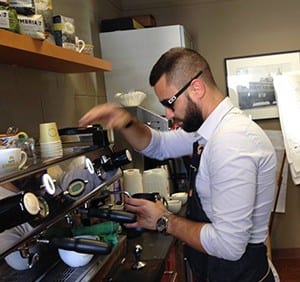
- Photo: Italian barista at work
Unlike cafés in America or in other parts of the world which propose the same menu around the clock, the Italian bar offers different atmospheres and menus depending on the time of your visit. Such set times are early morning, lunch time, mid-afternoon and during the
aperitivo time which usually goes from 6pm to 8pm. Due to its eclecticism, the clientele of a single
bar can also vary greatly depending on the time of the day you choose for your visit.
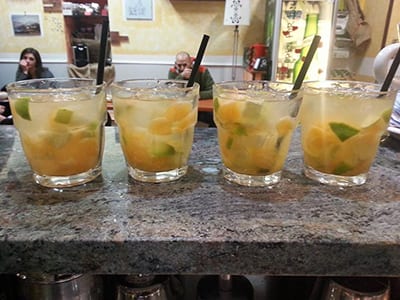 Photo: Mojitos are the most popular cocktails in Italy
Photo: Mojitos are the most popular cocktails in Italy
In the early morning, the
bar is ‘populated’ by workers who drink their morning coffee to get an energy boost on their way to work. This is a daily ritual for most Italian people who choose not to have breakfast at home and often visit the
bar to eat a quick
brioche, a custard or jam filled French croissant and drink a strong shot of espresso standing by the counter, while chatting with the baristas about sports or the weather or while reading the
bar’s copy of the daily newspaper.
During lunch time, the
bar changes atmosphere completely: tables are arranged like in a restaurant, table service is now offered and a complete menu including pasta dishes, salads and a selection of daily specials is presented on a chalkboard exposed just outside the
bar.
If you visit the bar around 4 o’clock in the afternoon you’ll find posh older ladies or moms pushing strollers who are drinking their tea while gossiping about their neighbors or perhaps groups of teens having a
granita, an Italian shaved ice, if it’s summer, or a hot chocolate if it’s winter.
Between 6pm and 8pm in the evening the
bar comes to life for the
aperitivo ! The Italian
aperitivo is an important moment of the day to meet with friends over a drink. The Italian
aperitivo started to gain popularity in Milan in the 1920s when people started gathering in local bars to have a bitter drink and some snacks after work.
The word
aperitivo comes from the Latin word for ‘open’ (
aperire) and, just like an appetizer, the
aperitivo serves the purpose of stimulating the appetite before dinner time. During this time of the day Italian
bars serve a wide range of snacks on a tray or buffet style appetizers which are free of charge with the purchase of a drink.
The typical drink to have during the
aperitivo is a bitter drink usually mixed with ‘Aperol’ or ‘Campari’ liquors which varies depending on the region. The most popular cocktail in Italy, the
mojito, is a mix of rum and mint and it is also popular at this time.
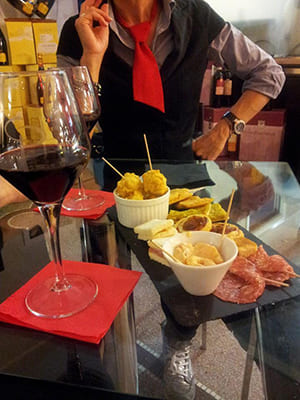
- Photo: tray-style aperitivo
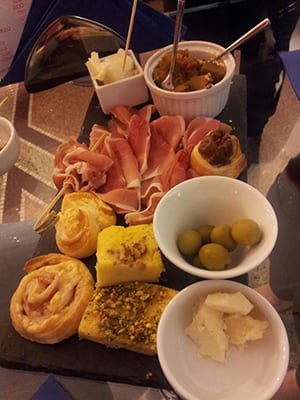
- Photo: Assorted aperitivo snacks
Italian
bars nowadays compete to offer the most fun and extravagant
aperitivo, sometimes having DJs play music, organizing themed nights or arranging funky contests with prizes such as the competition for the best high-heel shoes, the best dress or the funniest t-shirt. The
aperitivo is a time to leave work behind, stimulate the appetite and catch up with new and old friends.
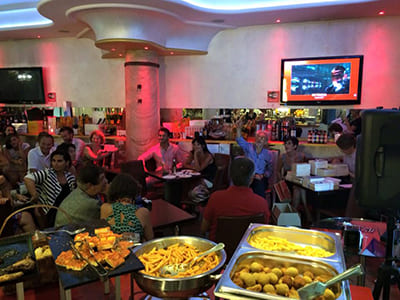 Photo: buffet-style aperitivo
Photo: buffet-style aperitivo

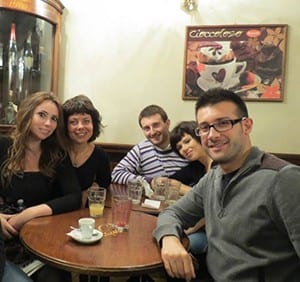
 Photo: Mojitos are the most popular cocktails in Italy
In the early morning, the bar is ‘populated’ by workers who drink their morning coffee to get an energy boost on their way to work. This is a daily ritual for most Italian people who choose not to have breakfast at home and often visit the bar to eat a quick brioche, a custard or jam filled French croissant and drink a strong shot of espresso standing by the counter, while chatting with the baristas about sports or the weather or while reading the bar’s copy of the daily newspaper.
During lunch time, the bar changes atmosphere completely: tables are arranged like in a restaurant, table service is now offered and a complete menu including pasta dishes, salads and a selection of daily specials is presented on a chalkboard exposed just outside the bar.
If you visit the bar around 4 o’clock in the afternoon you’ll find posh older ladies or moms pushing strollers who are drinking their tea while gossiping about their neighbors or perhaps groups of teens having a granita, an Italian shaved ice, if it’s summer, or a hot chocolate if it’s winter.
Between 6pm and 8pm in the evening the bar comes to life for the aperitivo ! The Italian aperitivo is an important moment of the day to meet with friends over a drink. The Italian aperitivo started to gain popularity in Milan in the 1920s when people started gathering in local bars to have a bitter drink and some snacks after work.
The word aperitivo comes from the Latin word for ‘open’ (aperire) and, just like an appetizer, the aperitivo serves the purpose of stimulating the appetite before dinner time. During this time of the day Italian bars serve a wide range of snacks on a tray or buffet style appetizers which are free of charge with the purchase of a drink.
The typical drink to have during the aperitivo is a bitter drink usually mixed with ‘Aperol’ or ‘Campari’ liquors which varies depending on the region. The most popular cocktail in Italy, the mojito, is a mix of rum and mint and it is also popular at this time.
Photo: Mojitos are the most popular cocktails in Italy
In the early morning, the bar is ‘populated’ by workers who drink their morning coffee to get an energy boost on their way to work. This is a daily ritual for most Italian people who choose not to have breakfast at home and often visit the bar to eat a quick brioche, a custard or jam filled French croissant and drink a strong shot of espresso standing by the counter, while chatting with the baristas about sports or the weather or while reading the bar’s copy of the daily newspaper.
During lunch time, the bar changes atmosphere completely: tables are arranged like in a restaurant, table service is now offered and a complete menu including pasta dishes, salads and a selection of daily specials is presented on a chalkboard exposed just outside the bar.
If you visit the bar around 4 o’clock in the afternoon you’ll find posh older ladies or moms pushing strollers who are drinking their tea while gossiping about their neighbors or perhaps groups of teens having a granita, an Italian shaved ice, if it’s summer, or a hot chocolate if it’s winter.
Between 6pm and 8pm in the evening the bar comes to life for the aperitivo ! The Italian aperitivo is an important moment of the day to meet with friends over a drink. The Italian aperitivo started to gain popularity in Milan in the 1920s when people started gathering in local bars to have a bitter drink and some snacks after work.
The word aperitivo comes from the Latin word for ‘open’ (aperire) and, just like an appetizer, the aperitivo serves the purpose of stimulating the appetite before dinner time. During this time of the day Italian bars serve a wide range of snacks on a tray or buffet style appetizers which are free of charge with the purchase of a drink.
The typical drink to have during the aperitivo is a bitter drink usually mixed with ‘Aperol’ or ‘Campari’ liquors which varies depending on the region. The most popular cocktail in Italy, the mojito, is a mix of rum and mint and it is also popular at this time.

 Photo: buffet-style aperitivo
Photo: buffet-style aperitivo













